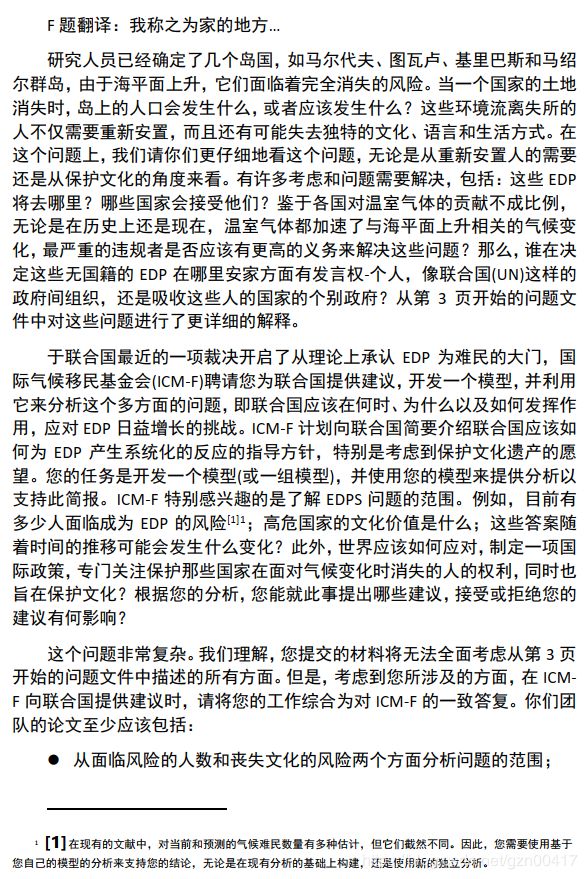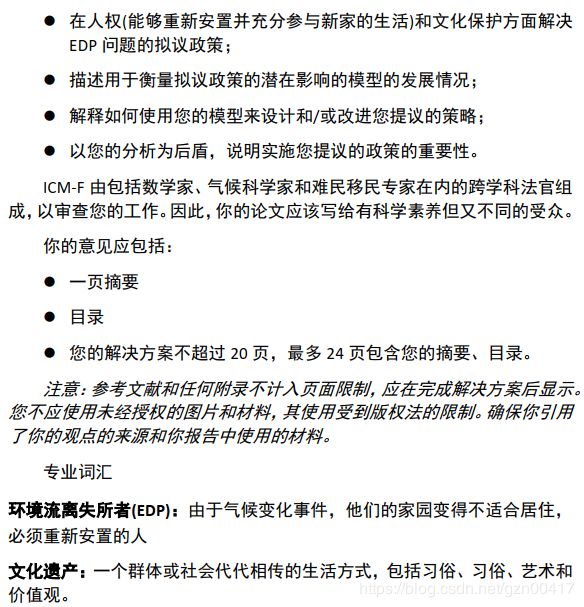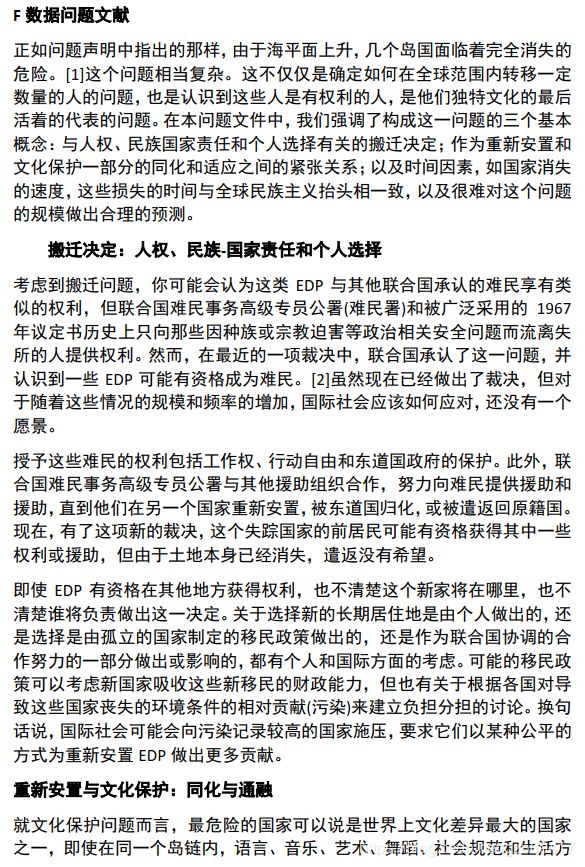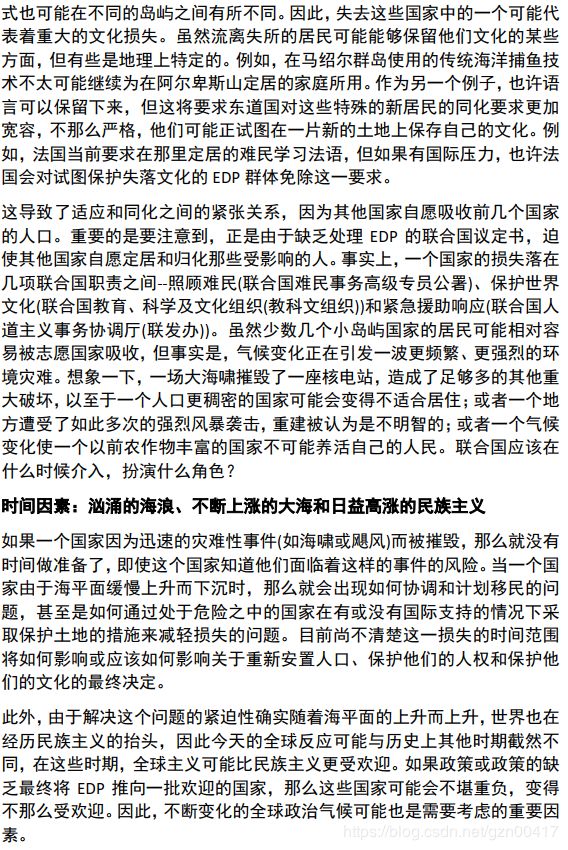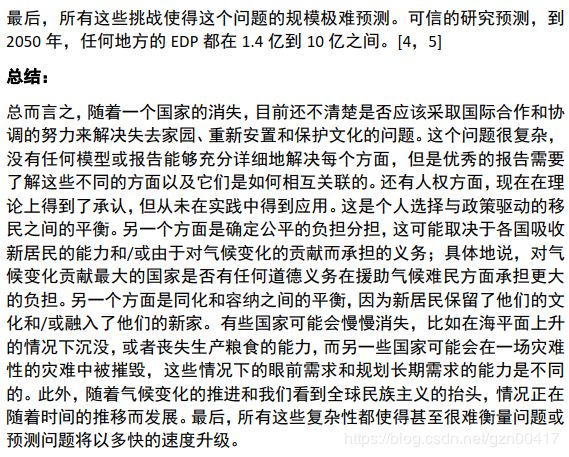2020美赛建模F题思路和理解
2020 MCM/ICM 美国大学生数学建模竞赛(MCM/ICM)F题
2020 ICM Weekend 2
Problem F: The Place I Called Home…
思路和理解
问题中心:设计模型研究海平面上升对相关国家的人口、文化的影响
- 简要思路:该问题很复杂,涉及到人文管理方面的专业知识。简化问题之前需要先收集海平面高程数据,在现有全球变暖趋势恒定的情况下对某时刻海平面变化做出预测。
-
问题1(海平面威胁模型)
人口:考虑人口的空间分布特征,结合题中所述地区的数字高程模型,分析海平面上升对沿海区域的威胁范围。或至少将人口数量变化建模为关于国土面积的函数,定量分析受威胁的人口数量。
文化:一个简单的思路是文化遗产建模为关于习俗、艺术、价值观等的函数,这些因素与人口数量有直接的关系。 -
问题2(政策结论模型)
考虑带搬迁问题,需要制定相应的搬迁资格。该问题落脚在制定移民政策。类比于这几天关注较高的外国人在华永久居住政策。关于人权,这些问题比较敏感,一定要慎重分析,能力有限,分析浅薄。这里的政策取决于问题3的建模结论,又指导问题3模型的改进方向。 -
问题3:移民机制模型
该问题也许是开放性问题,提出的安置政策只要保证受威胁人民的自由、妥善即可。而文化与人是分不开的,只要给出合理的移民方案,使得海平面上升的速率与提出政策(移民机制模型)达到拟合。你的模型需要首先假设海平面上升是不可逆的(即不考虑人类的改变使得全球变冷),模拟马尔代夫等国从现有状态逐渐消失的过程,保证这个过程中人口的平衡。 -
问题4:(模型改进)
可以考虑全球变暖的控制程度,将全球碳排放等代表时序数据利用起来,模型中加入海平面变化指数等类似的变量,进而改进每年安置人口的数量等。 -
问题5:(模型评价)
解释你们模型解决问题的有效性,预期效果等。
原题目翻译
原题目
2020 ICM Weekend 2
Problem F: The Place I Called Home…
Researchers have identified several island nations, such as The Maldives, Tuvalu, Kiribati, and
The Marshall Islands, as being at risk of completely disappearing due to rising sea levels. What
happens, or what should happen, to an island’s population when its nation’s land disappears? Not
only do these environmentally displaced persons (EDPs) need to relocate, but there is also risk
of losing a unique culture, language, and way of life. In this problem, we ask you to look more
closely at this issue, in terms of both the need to relocate people and the protection of culture.
There are many considerations and questions to address, to include: Where will these EDPs go?
What countries will take them? Given various nations’ disproportionate contributions to the
green-house gasses both historically and currently that have accelerated climate change linked to
the rising seas, should the worst offenders have a higher obligation to address these issues? And,
who gets a say in deciding where these nationless EDPs make a new home – the individuals, an
intergovernmental organization like the United Nations (UN), or the individual governments of
the states absorbing these persons? A more detailed explanation of these issues is given in the
Issue Paper beginning on page 3.
As a result of a recent UN ruling that opened the door to the theoretical recognition of EDPs as
refugees, the International Climate Migration Foundation (ICM-F) has hired you to advise the
UN by developing a model and using it to analyze this multifaceted issue of when, why, and how
the UN should step into a role of addressing the increasing challenge of EDPs. The ICM-F plans
to brief the UN on guidance for how the UN should generate a systemized response for EDPs,
especially in consideration of the desire to preserve cultural heritage. Your assignment is to
develop a model (or set of models) and use your model(s) to provide the analysis to support this
briefing. The ICM-F is especially interested in understanding the scope of the issue of EDPs. For
example, how many people are currently at risk of becoming EDPs[1]; what is the value of the
cultures of at-risk nations; how are those answers likely to change over time? Furthermore, how
should the world respond with an international policy that specifically focuses on protecting the
rights of persons whose nations have disappeared in the face of climate change while also aiming
to preserve culture? Based on your analysis, what recommendations can you offer on this matter,
and what are the implications of accepting or rejecting your recommendations?
This problem is extremely complex. We understand that your submission will not be able to fully
consider all of the aspects described in the Issue Paper beginning on page 3. However,
considering the aspects that you address, synthesize your work into a cohesive answer to the
ICM-F as they advise the UN. At a minimum, your team’s paper should include:
An analysis of the scope of the issue in terms of both the number of people at risk and the
risk of loss of culture;
Proposed policies to address EDPs in terms of both human rights (being able to resettle
and participate fully in life in their new home) and cultural preservation;
A description of the development of a model used to measure the potential impact of
proposed policies;
[1] There are multiple estimates for the current and predicted number of climate refugees in the existing literature,
but they are vastly different. Therefore, you need to support your conclusions with analysis based on your own
model(s), either building off of existing analysis or with a new and independent analysis. An explanation of how your model was used to design and/or improve your proposed
policies;
An explanation, backed by your analysis, of the importance of implementing your
proposed policies.
The ICM-F consists of interdisciplinary judges including mathematicians, climate scientists, and
experts in refugee migration to review your work. Therefore, your paper should be written for a
scientifically literate yet diverse audience.
Your submission should consist of:
One-page Summary Sheet
Table of Contents
Your solution of no more than 20 pages, for a maximum of 22 pages with your summary
and table of contents.
NOTE: Reference List and any appendices do not count toward the page limit and should appear
after your completed solution. You should not make use of unauthorized images and materials
whose use is restricted by copyright laws. Ensure you cite the sources for your ideas and the
materials used in your report.
Glossary
Environmentally displaced persons (EDPs): people who must relocate as their homeland
becomes uninhabitable due to climate change events
Cultural heritage: the ways of living of a group or society passed through generations to
include customs, practices, art, and values.ICM Problem F
Issue Paper
As noted in the problem statement, several island nations are at risk of completely disappearing
due to rising sea levels.[1] The issue is quite complex. It is not simply a matter of identifying how
to move a certain number of people around the globe – it is also about recognizing that these
people are human beings who have rights and who are the last living representatives of their
unique culture. In this Issue Paper, we highlight three of the essential ideas that frame this
problem: relocation decisions as they relate to human rights, nation-state responsibility, and
individual choice; the tension between assimilation and accommodation as part of resettlement
and cultural preservation; and time factors such as the rate of the nation disappearing, the timing
of these losses aligning with a global rise in nationalism, and the difficulty in making sound
predictions about the size of this issue.
Relocation Decisions: Human Rights, Nation-State Responsibility, and Individual Choice
Considering the relocation issue, you might think that such EDPs would have similar rights as
other UN-recognized refugees, but the United Nations High Commission on Refugees (UNHCR)
and the widely adopted 1967 protocol has historically only afforded rights to those who are
displaced due to politically related security issues, such as ethnic or religious persecution.
However, in a very recent ruling, the UN has acknowledged this issue and recognized that some
EDPs might qualify as refugees.[2] Although a ruling has now been made, there is not yet a vision
on how the international community should respond as these situations increase in magnitude
and frequency.[3]
Rights awarded to these refugees include right to work, freedom of movement, and protection by
host governments. Additionally, the UNHCR, in collaboration with other aid organizations, work
to provide aid and assistance to refugees until they are resettled in another country, become
naturalized by their host state, or repatriate to their country of origin. Now, with this new ruling,
the former inhabitants of the disappeared nation may be eligible for some of those rights or aid,
but there is no hope of repatriation as the land itself is gone.
Even if EDPs are eligible for rights somewhere else, it is not clear where this new home would
be or who would be responsible for making that decision. There are individual and international
considerations related to whether the selection of a new long-term residence is made by
individuals or if the choices are made or swayed by immigration policies developed by nations in
isolation or as part of a cooperative effort coordinated by the United Nations. Possible migration
policies could consider the financial ability of the new nation to absorb these new individuals,
but there is also discussion of setting up burden-sharing based on nations’ relative contributions
(pollution) to the environmental conditions that is leading to the loss of these nations. In other
words, the international community may press nations with high pollution records to contribute
more to the resettlement of EDPs in some equitable manner.
Resettlement and Cultural Preservation: Assimilation versus Accommodation
In terms of the cultural preservation issues, the nations that are most at risk are arguably some of
the most culturally distinct in the world with languages, music, art, dances, social norms, and
ways of life that can be different from island to island even within the same island chain. As a
result, the loss of one of these nations could represent a significant cultural loss. While the
displaced inhabitants may be able to preserve some aspects of their culture, some are
geographically specific. For example, traditional ocean fishing techniques used in The MarshallIslands are unlikely to continue to be practiced by families who settle in the Alps. As another
example, perhaps the language could be preserved, but this would require host nations to be
more accommodating and less strict on the assimilation requirements of these special new
residents who may be trying to preserve their culture in a new land. For example, France current
requires refugees who resettle there to learn French, but if there were international pressure,
perhaps France would waive this requirement for groups of EDPs who are trying to preserve a
lost culture.
This leads to a tension between accommodation and assimilation as other nations volunteer to
absorb the populations of the former nations. It is important to note that it is the lack of a UN
protocol for dealing with EDPs that forces other nations to volunteer to settle and naturalize
those affected. In fact, the loss of a nation falls into the no-man’s land between several UN
charges – the care of refugees (UNHCR), the protection of world culture (United Nations
Educational, Scientific, and Cultural Organization (UNESCO)), and emergency aid response
(United Nations Office for the Coordination of Humanitarian Affairs (UNOCHA)). And while
the residents of a handful of small island nations might be absorbed relatively easily by volunteer
nations, the fact is that climate change has been ushering a literal wave of more frequent and
more intense environmental disasters. Imagine a major tsunami taking out a nuclear power plant
and causing enough other significant damage that a more heavily inhabited nation may become
uninhabitable; or a place being hit by so many repeated severe storms that rebuilding was
deemed unwise; or a place where climate change is making it impossible for a nation that was
formerly flush with crops to provide for its people. At what point should the UN step in, and in
what role?
Time Factors: Raging Waves, Rising Seas, and Rising Nationalism
If a nation is wiped out as a result of a rapid catastrophic event, such as a tsunami or hurricane,
then there is no time to prepare, even if the country knew they were at risk of such an event.
When a nation is sinking as a result of slowly rising sea levels, then there are issues about how a
migration could be coordinated and planned, or even how the loss could be mitigated through
land-preserving measures taken by the at-risk nation with or without international support. It is
not clear how the timescale of the loss would impact, or should impact, the ultimate decisions
that need to be made concerning the resettlement of a population, the protection of their human
rights, and the preservation of their culture.
Additionally, as the urgency to address this issue is literally rising with the sea level, the world is
also experiencing a rise of nationalism, so the global response today may be very different than it
would have been at other periods in history where globalism may have been more in favor than
nationalism. If policies, or a lack of policies, end up pushing EDPs towards a subset of
welcoming nations, then those countries may get overwhelmed and become less welcoming in
response. Therefore, the changing global political climate may also be an important factor to
consider.
Lastly, all of these challenges make the size of this problem extremely difficult to predict.
Credible studies have predicted anywhere from 140 million to one billion EDPs by 2050.[4,5]
Summary:
In summary, as a nation disappears, it is not clear if an international cooperative and coordinated
effort should be adopted to address the loss of homes, the need to resettle, and the preservation of
culture. This issue is complex, and no model or report would be able to adequately address everyaspect in detail, but excellent reports need to be aware of these different aspects and how they are
interrelated. There is the aspect of human rights, which are now recognized in theory, but have
never been applied in practice. There is the balance of individual choice versus policy-driven
migration. Another aspect is defining equitable burden sharing which could be driven by the
capacity for nations to absorb new residents and/or obligations due to contributions to climate
change; specifically, whether the nations with the largest contributions to climate change have
any ethical obligations to take on a higher burden in assisting climate refugees. Yet another
aspect is a balance between assimilation and accommodation, as new residents preserve their
culture and/or blend into their new home. Some nations may disappear slowly, such as sinking
under rising sea levels or loss of the ability to produce food, while other nations may be wiped
out in a catastrophic disaster; and the immediate needs and ability to plan for the long-term needs
in these situations are different. Furthermore, the situation is evolving over time as climate
change advances and as we see a global rise in nationalism. Lastly, all of this complexity has
made it difficult to even measure the problem or predict how quickly it will escalate.
Cited References
Note that these are provided as citations to support claims in the Issue Paper. We have already
pulled the important ideas from these resources for you, so although your team may use these
sources, access to these is not required. Instead your team is encouraged to look for other sources
to support your claims.
[1] Letman, J. (2018, November 19). Rising seas give island nation a stark choice: relocate or
elevate. National Geographic. Retrieved from
https://www.nationalgeographic.com/environment/2018/11/rising-seas-force-marshall-islandsrelocate-elevate-artificial-islands/.
[2] Young, M. (2019, December 9). Climate Refugees Refused UN Protection & Denied Rights
Under International Law. Retrieved from http://www.ipsnews.net/2019/12/climate-refugeesrefused-un-protection-denied-rights-international-law/.
[3] Su, Y. (2020, January 29). UN ruling on climate refugees could be gamechanger for climate
action. Retrieved from https://www.climatechangenews.com/2020/01/29/un-ruling-climaterefugees-gamechanger-climate-action/.
[4] The World Bank Report. (2018, March 19). Climate Change Could Force Over 140-Million
to Migration Within Countries by 2050. Retrieved from
https://www.worldbank.org/en/news/press-release/2018/03/19/climate-change-could-force-over-
140-million-to-migrate-within-countries-by-2050-world-bank-report.
[5] Kamal, B. (2017, August 21). Climate Migrants Might Reach One Billion by 2050. Retrieved
from http://www.ipsnews.net/2017/08/climate-migrants-might-reach-one-billion-by-2050/.
